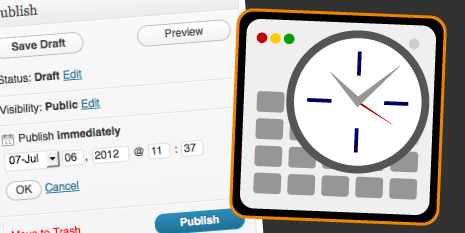
The second post in a two part series, I’m considering the cons of scheduling the publication of content, particularly as that functionality relates to inbound marketing for small businesses.
As you can read in the 5 Pros of Scheduling Post Content, I had intended to run this series over the course of two weeks. But then a significant back injury threw a few hurdles in the way and I am only getting around to publishing the cons side of the conversation a month later. I suppose we can add this anecdote to the pro side of the argument.
Cheers to Dave Miller for the push on Twitter to get this post live!
https://twitter.com/DaveJamesMiller/statuses/232054849095729152
Cons of Scheduling Posting
1. Appearing to be everywhere
It’s a matter of fact. A reality for small businesses. It’s simply not possible to be everywhere at all times. We don’t have the staff numbers to manage that. We also have work to do — we can’t always be marketing ourselves. There is a chance that if we appear to be everywhere on social media, especially when we had a major client project due, that this omnipresence could cause confusion and tension with our clients.
2. Lacking relevancy
Conversations move quickly on the internet. What we schedule for publication next week might no longer be relevant at that point. Someone else might have found the answer, developed a work-around or already shared the news. Pre-scheduled content can make us look old hat.
3. Seeming out of touch
Major global and local events happen every day. Taking a particular angle in a blog post that is appropriate this week might be completely insensitive or cruel next week. Our scheduled content can look sorely out of touch if something significant (and tragic) happens between the time we click the “schedule” button and the time it goes live on our blog or Twitter feed.
4. Failing to respond in real time
To be most effective, social media must focus on conversation. So, while our scheduled content may be poignant and fresh, if we’re out of the office for three days, we certainly won’t be able to respond to comments in the generally accepted time frame. It’s like we start a conversation and then walk out of the room before anyone has a chance to respond.
5. Forgetting the publication schedule
As small business owners, we’ve got a lot going on a daily basis. Keeping focused on what’s in front of us can be enough of a task without trying to recall what we’ve scheduled for publication tomorrow or next week. This runs the risk that we forget about our publication schedule, causing us to publish similar content twice or forget about the post that went live when we were on holiday.
In covering both sides of the coin, I have to say that I think there definitely is scope for scheduling posted content. Like most marketing approaches, using scheduled posts requires planning, forethought, savvy and a bit of luck.
What’s your take on it?
Pingback: 5 Pros of Scheduling Posted Content | Liam Dempsey
Thanks for the mention.
I think the best (worst) example for number 3 is Radiohead Toronto in June: http://www.unmarketing.com/2012/06/16/worst-scheduled-tweet-timing-ever/
Number 4 is a good point – I think apps like Buffer can be good for spreading your tweets out a bit, but it would be best to schedule it when you’re around to respond at least.
Personally I always post directly, not scheduled.
@ Dave –
Thank you for the reminder to complete this series. You’re keeping me on my toes — and that’s a good thing.
Great best worst example! That highlights my points (3) and (5). You know whoever scheduled that tweet totally forgot about it.
I think the key is you can’t just rely on scheduling posts. Not only does it open you up to certain snafus related to an untimely related event, but it’s more broadcasting than building a relationship. That said, I prefer a mix of both direct posts and scheduling. Scheduling can give you a nice base to work from, but, as always, it pays to be flexible.
@ Coreen,
Nicely said on the broadcasting point. You succinctly phrased my general concern with scheduled posts — better than I did.
I’m not totally against scheduled posts. Rather I think that they need to be used with caution and understanding.